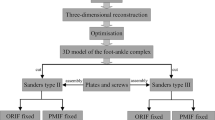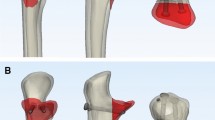Abstract
Open reduction and internal fixation (ORIF) with plate is the standard treatment for displaced intra-articular calcaneal fractures. We constructed a three-dimensional complete foot finite element model, which was also modified to evaluate the biomechanical effect of Sanders IIB tongue-type calcaneal fracture treated by ORIF with locking plate. We compared plates with locking screws (LSs) and those with non-locking screws (NSs). Static standing was simulated by applying ground reaction force and the pulling force of the Achilles tendon. ORIF with plate using NS or LS provided good stability for Sanders IIB tongue-type calcaneal fracture and might allow light touch weight-bearing in the early postoperative period.









Similar content being viewed by others
References
Richter, M., Gosling, T., Zech, S., Allami, M., Geerling, J., Droste, P., et al. (2005). A comparison of plates with and without locking screws in a calcaneal fracture model. Foot and Ankle International, 26(4), 309–319.
Stoffel, K., Booth, G., Rohrl, S. M., & Kuster, M. (2007). A comparison of conventional versus locking plates in intraarticular calcaneus fractures: A biomechanical study in human cadavers. Clinical Biomechanics, 22(1), 100–105.
Chen, K., Zhang, H., Wang, G., Cheng, Y., Qian, Z., & Yang, H. (2014). Comparison of nonlocking plates and locking plates for intraarticular calcaneal fracture. Foot and Ankle International, 35(12), 1298–1302.
Redfern, D. J., Oliveira, M. L., Campbell, J. T., & Belkoff, S. M. (2006). A biomechanical comparison of locking and nonlocking plates for the fixation of calcaneal fractures. Foot and Ankle International, 27(3), 196–201.
Blake, M. H., Owen, J. R., Sanford, T. S., Wayne, J. S., & Adelaar, R. S. (2011). Biomechanical evaluation of a locking and nonlocking reconstruction plate in an osteoporotic calcaneal fracture model. Foot and Ankle International, 32(4), 432–436.
Illert, T., Rammelt, S., Drewes, T., Grass, R., & Zwipp, H. (2011). Stability of locking and non-locking plates in an osteoporotic calcaneal fracture model. Foot and Ankle International, 32(3), 307–313.
Yu, B., Chen, W.-C., Lee, P.-Y., Lin, K.-P., Lin, K.-J., Tsai, C.-L., et al. (2016). Primary stability of absorbable screw fixation for intra-articular calcaneal fractures: A finite element analysis. Computer Methods in Biomechanics and Biomedical Engineering. doi:10.1080/10255842.2016.1142534.
Ni, M., Weng, X.-H., Mei, J., & Niu, W.-X. (2015). Primary stability of absorbable screw fixation for intra-articular calcaneal fractures: A finite element analysis. Journal of Medical and Biological Engineering, 35(2), 236–241.
Pang, Q.-J., Yu, X., & Guo, Z.-H. (2014). The sustentaculum tali screw fixation for the treatment of Sanders type II calcaneal fracture: A finite element analysis. Pakistan Journal of Medical Sciences, 30(5), 1099.
Wright, D., & Rennels, D. (1964). A study of the elastic properties of plantar fascia. Journal of Bone and Joint Surgery (American Volume), 46(3), 482–492.
Siegler, S., Block, J., & Schneck, C. D. (1988). The mechanical characteristics of the collateral ligaments of the human ankle joint. Foot and Ankle International, 8(5), 234–242.
Lemmon, D., Shiang, T., Hashmi, A., Ulbrecht, J. S., & Cavanagh, P. R. (1997). The effect of insoles in therapeutic footwear—A finite element approach. Journal of Biomechanics, 30(6), 615–620.
Cheung, J. T.-M., An, K.-N., & Zhang, M. (2006). Consequences of partial and total plantar fascia release: A finite element study. Foot and Ankle International, 27(2), 125–132.
Follet, H., Peyrin, F., Vidal-Salle, E., Bonnassie, A., Rumelhart, C., & Meunier, P. (2007). Intrinsic mechanical properties of trabecular calcaneus determined by finite-element models using 3D synchrotron microtomography. Journal of Biomechanics, 40(10), 2174–2183.
Simkin, A. (1982). Structural analysis of the human foot in standing posture. Tel-Aviv University.
Hsu, Y.-C., Gung, Y.-W., Shih, S.-L., Feng, C.-K., Wei, S.-H., Yu, C.-H., et al. (2008). Using an optimization approach to design an insole for lowering plantar fascia stress—A finite element study. Annals of Biomedical Engineering, 36(8), 1345–1352.
Sanders, R., Fortin, P., DiPasquale, T., & Walling, A. (1993). Operative treatment in 120 displaced intraarticular calcaneal fractures results using a prognostic computed tomography scan classification. Clinical Orthopaedics and Related Research, 290, 87–95.
Essex-Lopresti, P. (1952). The mechanism, reduction technique, and results in fractures of the os calcis. British Journal of Surgery, 39(157), 395–419.
Chang, C.-L., Chen, C.-S., Huang, C.-H., & Hsu, M.-L. (2012). Finite element analysis of the dental implant using a topology optimization method. Medical Engineering and Physics. doi:10.1016/j.medengphy.2012.06.004.
Pendergast, M., & Rusovici, R. (2015). A finite element parametric study of clavicle fixation plates. International Journal for Numerical Methods in Biomedical Engineering. doi:10.1002/cnm.2710.
Sun, P.-C., Shih, S.-L., Chen, Y.-L., Hsu, Y.-C., Yang, R.-C., & Chen, C.-S. (2012). Biomechanical analysis of foot with different foot arch heights: A finite element analysis. Computer Methods in Biomechanics and Biomedical Engineering, 15(6), 563–569.
Schepers, T., van Lieshout, E. M., Ginai, A. Z., Mulder, P. G., Heetveld, M. J., & Patka, P. (2009). Calcaneal fracture classification: A comparative study. The Journal of Foot and Ankle Surgery, 48(2), 156–162.
Acknowledgements
This study was supported partly by Taipei Veterans General Hospital (V104C-177 and V106C-145) and by Ministry of Science and Technology, ROC (MOST 104-2314-B-075-002).
Author information
Authors and Affiliations
Corresponding author
Rights and permissions
About this article
Cite this article
Chen, CH., Huang, YH., Hung, C. et al. Finite Element Analysis of Tongue Type Calcaneal Fracture with Open Reduction and Internal Fixation with Locking Plate. J. Med. Biol. Eng. 38, 1–9 (2018). https://doi.org/10.1007/s40846-017-0296-3
Received:
Accepted:
Published:
Issue Date:
DOI: https://doi.org/10.1007/s40846-017-0296-3




